Study on the Impact Resistance of FRP Pasted onto a Blastproof Partition Wall under Out-of-Plane Repeated Impact Load
Abstract
1. Introduction
2. Experimental Tests
2.1. Specimen Design
2.2. Material Properties
2.3. Pendulum Impact Device
3. Analysis of Pendulum Impact Test Results
3.1. Destruction Form
3.2. Impact Response Curve
3.3. Crack Morphology
3.4. Strain Time-History Curve
3.5. FRP Impact Resistance Contribution
4. Parametric Analysis
4.1. FRP Type
4.2. Number of FRP Layers
4.3. FRP Width
5. Comparison between Finite Element Simulation Results and Experiments
5.1. Finite Element Model
5.2. Damage Comparison
5.3. Comparison of Response Curves
6. Conclusions
- (1)
- Under the action of multiple pendulum impact loads, the blastproof partition wall without FRP was severely bent, the concrete fell off, and the steel bar was exposed. When the back of the wall was pasted with FRP, the lateral bending stiffness increased, and the peak impact force increased by 43.8%.
- (2)
- The tensile fracture strain value of FRP has a great influence on the resistance of the blastproof partition wall to multiple impact loads. FRP will elastically retract during the impact process. The impact recovery coefficient increased from 0.33 to 0.57, so the crack width of concrete decreased by 80.6%.
- (3)
- Large-rupture-strain FRP pasted onto the back of the blastproof partition wall is more capable of resisting multiple impact loads. Large-rupture-strain FRP can give full play to the advantages of a large tensile fracture strain, and the wall’s residual displacement is reduced by 59%. After multiple impacts, no fracture or peeling occurs, and the bonding performance with concrete is good.
- (4)
- The finite element simulation results show that the material model selected in this study can simulate the pendulum impact well. The failure mode of FRP pasted on the blastproof partition wall can be more accurately predicted, and this provides an effective method for predicting the impact damage in practical engineering.
Author Contributions
Funding
Institutional Review Board Statement
Informed Consent Statement
Data Availability Statement
Conflicts of Interest
References
- Luccioni, B.M.; Ambrosini, R.D.; Danesi, R.F. Analysis of building collapse under blast loads. Eng. Struct. 2004, 26, 63–71. [Google Scholar] [CrossRef]
- Ohkubo, K.; Beppu, M.; Ohno, T.; Satoh, K. Experimental study on the effectiveness of fiber sheet reinforcement on the explosive-resistant performance of concrete plates. Int. J. Impact Eng. 2008, 35, 1702–1708. [Google Scholar] [CrossRef]
- Öztürk, B.; Yilmaz, C.; Şentürk, T. Effect of FRP retrofitting application on seismic behavior of a historical building at Nigde, Turkey. In Proceedings of the 14th European Conference on Earthquake Engineering, Ohrid, Republic of Macedonia, 30 August–3 September 2010. [Google Scholar]
- Lin, X.; Zhang, Y.; Hazell, P.J. Modelling the response of reinforced concrete panels under blast loading. Mater. Des. 2014, 56, 620–628. [Google Scholar] [CrossRef]
- Lawver, D.; Daddazio, R.; Oh, G.J.; Stanley, M. Simulating the response of composite reinforced floor slabs subjected to blast loading. In Proceedings of the ASME 2003 International Mechanical Engineering Congress and Exposition, Washington, DC, USA, 15 November 2003; pp. 15–21. [Google Scholar]
- Buchan, P.A.; Chen, J. Blast resistance of FRP composites and polymer strengthened concrete and masonry structures—A state-of-the-art review. Compos. Part B Eng. 2007, 38, 509–522. [Google Scholar] [CrossRef]
- Shen, Y.; Dai, M.; Pu, W.; Xiang, Z. Effects of content and length/diameter ratio of PP fiber on explosive spalling resistance of hybrid fiber-reinforced ultra-high-performance concrete. J. Build. Eng. 2022, 58, 105071. [Google Scholar] [CrossRef]
- Zhou, Y.; Shi, W.; Gao, Y.; Gao, J.; Ma, J. Experimental investigation on the dynamic mechanical response of polyethylene terephthalate fiber-reinforced polymer confined pre-flawed concrete under impact loading. J. Build. Eng. 2022, 57, 104966. [Google Scholar] [CrossRef]
- Almusallam, T.; Abadel, A.; Siddiqui, N.; Abbas, H. Impact behavior of hybrid-fiber reinforced concrete beams. Structures 2022, 39, 782–792. [Google Scholar] [CrossRef]
- Swesi, A.O.; Cotsovos, D.M.; Val, D.V. Effect of CFRP strengthening on response of RC columns to lateral static and impact loads. Compos. Struct. 2022, 287, 115356. [Google Scholar] [CrossRef]
- Pham, T.M.; Hao, H. Behavior of Fiber-reinforced Polymer-strengthened Reinforced Concrete Beams Under Static and Impact Loads. Int. J. Prot. Struct. 2017, 8, 3–24. [Google Scholar] [CrossRef]
- Chen, J.; Li, S.; Bisby, L. Factors affecting the ultimate condition of FRP wrapped concrete columns. J. Compos. Constr. 2013, 17, 67–78. [Google Scholar] [CrossRef]
- Malvar, L.J.; Crawford, J.E.; Morrill, K.B. Use of composites to resist blast. J. Compos. Constr. 2007, 11, 601–610. [Google Scholar] [CrossRef]
- Cho, S.; Min, K.; Kim, Y. Impact resistance evaluation of RC beams strengthened with carbon FRP sheet and steel fiber. J. Korea Concr. Inst. 2010, 22, 719–725. [Google Scholar] [CrossRef][Green Version]
- Kantar, E.; Anil, O. Low velocity impact behavior of concrete beam strengthened with CFRP strip. Steel Compos. Struct. 2012, 12, 207–230. [Google Scholar] [CrossRef]
- Pham, T.M.; Hao, H. Review of concrete structures strengthened with FRP against impact loading. Structures 2016, 7, 59–70. [Google Scholar] [CrossRef]
- Pham, T.M.; Hao, H. Axial impact resistance of FRP-confined concrete. J. Compos. Constr. 2017, 21, 04016088. [Google Scholar] [CrossRef]
- Shan, B.; Zhang, Y.; Monti, G.; Li, T.; Xiao, Y. Axial impact behavior of FRP-confined concrete stub columns with square and circular cross section. J. Compos. Constr. 2020, 24, 04020013. [Google Scholar] [CrossRef]
- Zhang, W.; Tang, Z. Numerical Modeling of Response of CFRP-concrete Interfaces Subjected to Fatigue Loading. J. Compos. Constr. 2021, 25, 04021043. [Google Scholar] [CrossRef]
- Huang, Z.; Chen, W.; Trant, T.; Pham, T.M.; Elchalakani, M. Experimental and Numerical Study on Concrete Beams Reinforced with Basalt FRP Bars Under Static and Impact Loads. Compos. Struct. 2021, 263, 113648. [Google Scholar] [CrossRef]
- Jin, L.; Xia, M.; Zhang, R.; Lin, M.; Du, X. Computational modeling and dynamic response of reinforced concrete shear wall under out-of-plane impact loading. Int. J. Impact Eng. 2022, 172, 104425. [Google Scholar] [CrossRef]
- Daneshvar, K.; Moradi, M.J.; Khaleghi, M.; Rezaei, M.; Farhangi, V.; Hajiloo, H. Effects of impact loads on heated-and-cooled reinforced concrete slabs. J. Build. Eng. 2022, 61, 105328. [Google Scholar] [CrossRef]
- Jin, L.; Yang, J.; Zhang, R.; Du, X. Modeling of GFRP-reinforced concrete slabs under various impact masses and velocities. Thin-Walled Struct. 2023, 182, 110175. [Google Scholar] [CrossRef]
- Zhao, Y.; Zhong, X.; Foong, L.K. Predicting the splitting tensile strength of concrete using an equilibrium optimization model. Steel Compos. Struct. 2021, 39, 81–93. [Google Scholar]
- Zhao, Y.; Wang, Z. Subset simulation with adaptable intermediate failure probability for robust reliability analysis: An unsupervised learning-based approach. Struct. Multidiscip. Optim. 2022, 65, 172. [Google Scholar] [CrossRef]
- Kishi, N.; Nakano, O.; Matsuoka, K.G.; Ando, T. Experimental study on ultimate strength of flexural-failure-type RC beams under impact loading. In Proceedings of the Transactions of the 16th International Conference on Structural Mechanics in Reactor Technology (SMIRT), Washington, DC, USA, 12–17 August 2001; pp. 1–7. [Google Scholar]
- ACI Committee. 440.2R-08 Guide for the Design and Construction of Externally Bonded FRP Systems for Strengthening Concrete Structures; American Concrete Institute: Farmington Hills, MI, USA, 2008; pp. 32–34. [Google Scholar]
- Zhao, W.; Guo, Q.; Dou, X.; Zhou, Y.; Ying, H. Impact response of steel-concrete composite panels: Experiments and FE analyses. Steel Compos. Struct. 2018, 26, 255–263. [Google Scholar]
- Murray, Y.D.; Abu-Odeh, A.; Bligh, R. Evaluation of LS-DYNA Concrete Material Model 159 [R]; Federal Highway Administration: McLean, VA, USA, 2007.
- Murray, Y.D. Users Manual for LS-DYNA Concrete Material Model 159; Report No. FHWA-HRT-05-062; Federal Highway Administration: McLean, VA, USA, 2007. [Google Scholar]
- Reddy, T.Y.; Reid, S.R. Axial splitting of circular metal tubes. Int. J. Mech. Sci. 1986, 28, 111–131. [Google Scholar] [CrossRef]
- Abramowicz, W.; Jones, N. Dynamic axial crushing of circular tubes. Int. J. Impact Eng. 1984, 2, 263–281. [Google Scholar] [CrossRef]
- Abramowicz, W.; Jones, N. Dynamic progressive buckling of circular and square tubes. Int. J. Impact Eng. 1986, 4, 243–270. [Google Scholar] [CrossRef]
- A1-Zubaidy, H.; Zhao, X.; Al-Mahaidi, R. Mechanical Characterisation of the Dynamic Tensile Properties of CFRP Sheet and Adhesive at Medium Strain Rates. Compos. Struct. 2013, 96, 153–164. [Google Scholar] [CrossRef]
- Zhang, X.H.; Hao, H.; Shi, Y.C.; Cui, J.; Zhang, X.J. Static and Dynamic Material Properties of CFR/Epoxy Laminates. Constr. Build. Mater. 2016, 114, 638–649. [Google Scholar] [CrossRef]
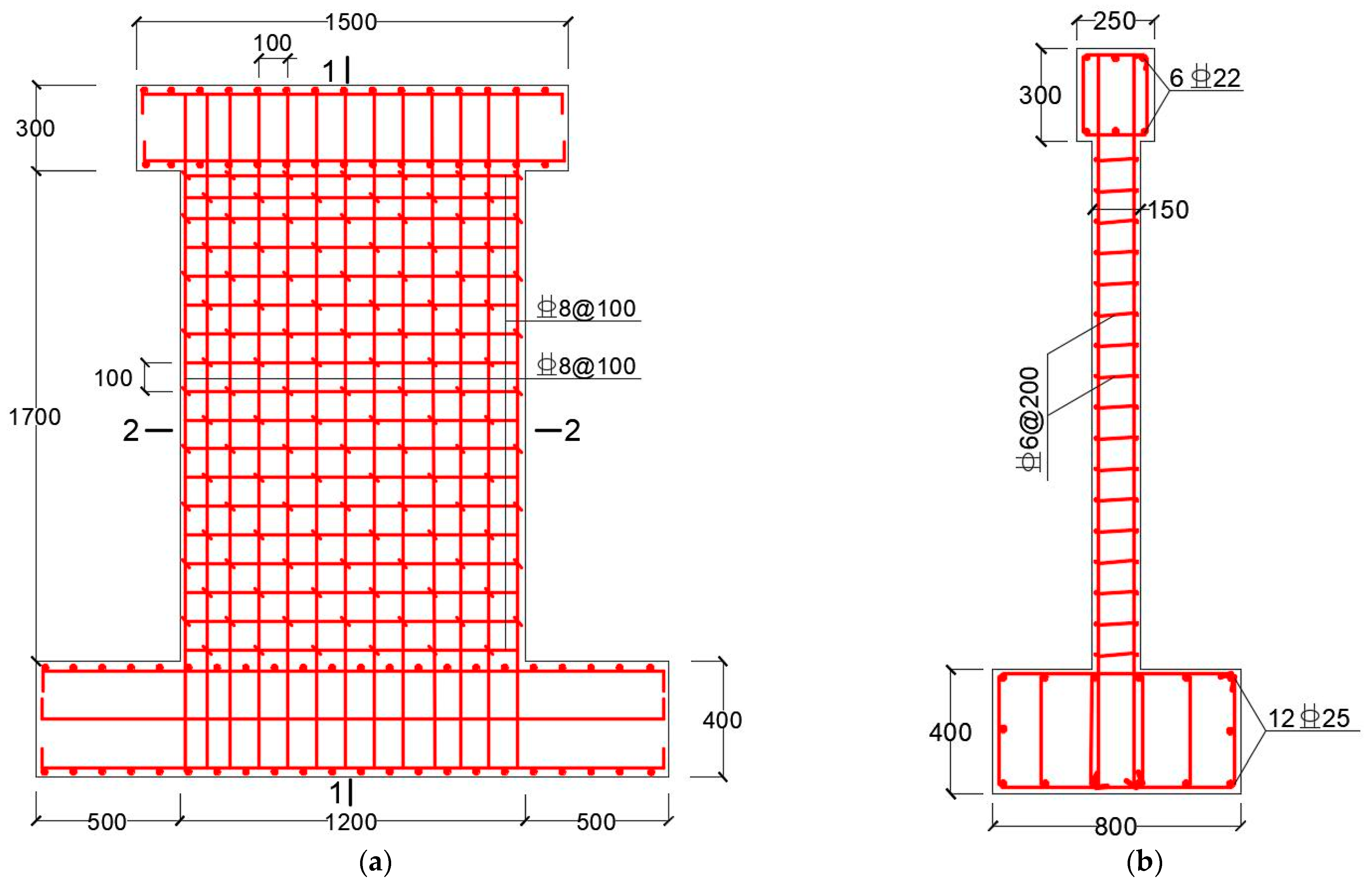

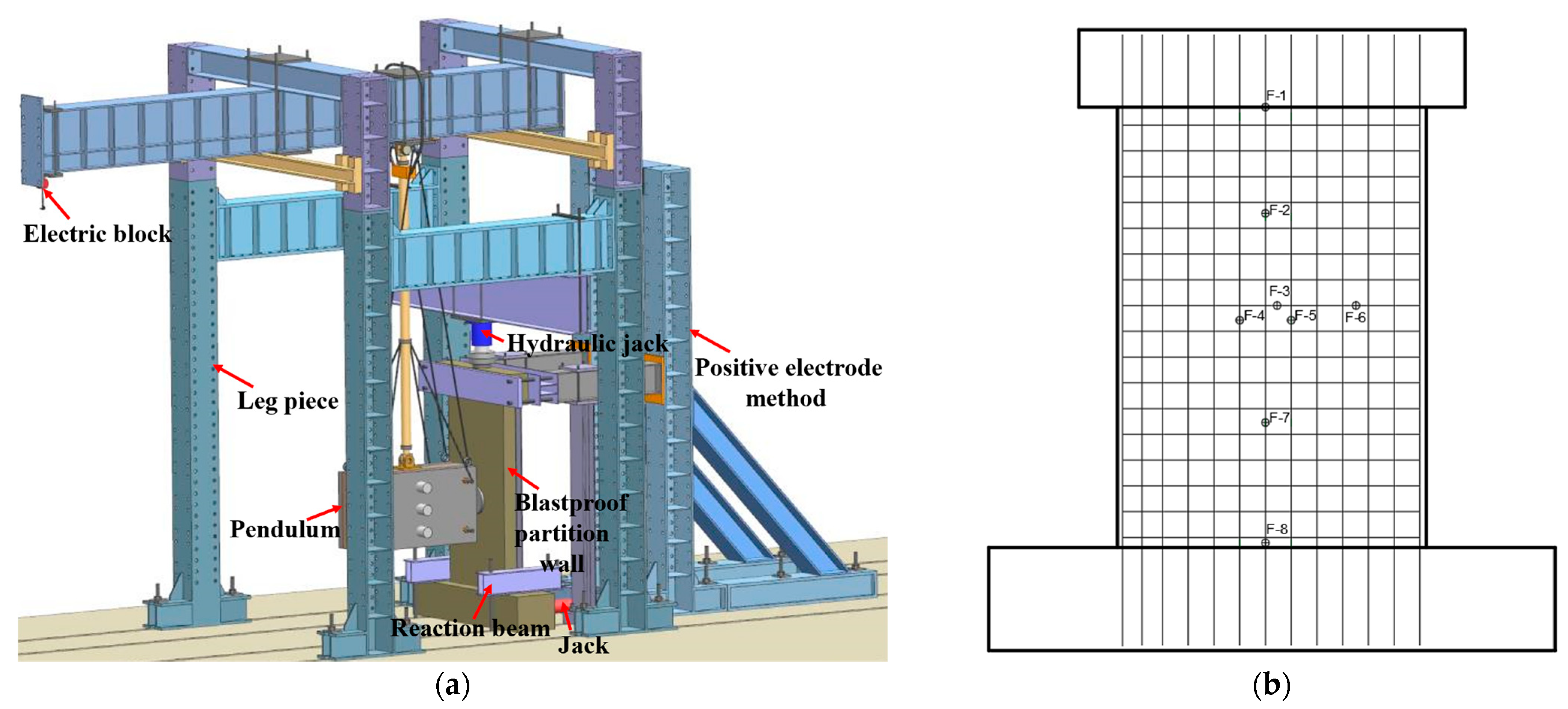
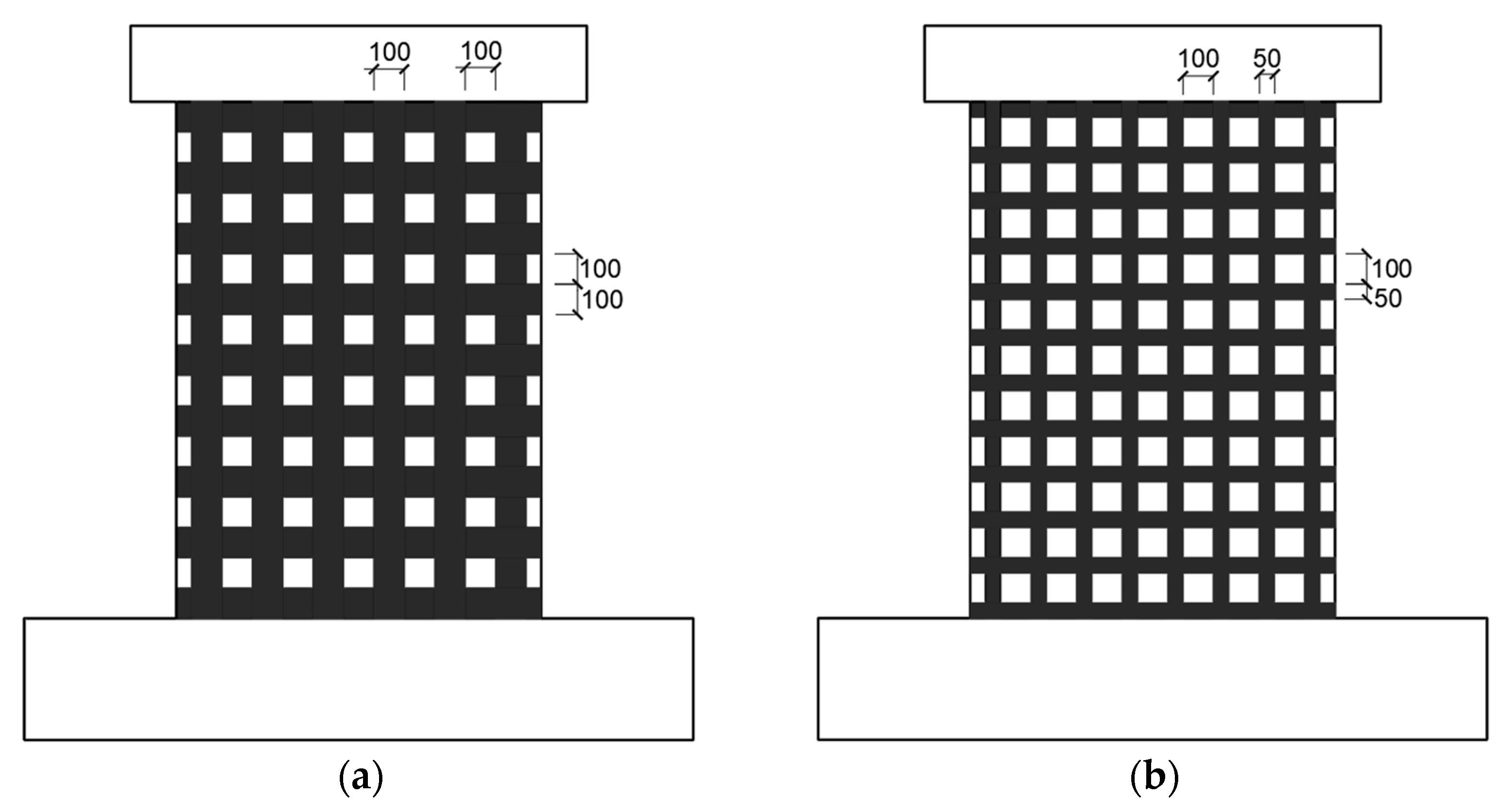


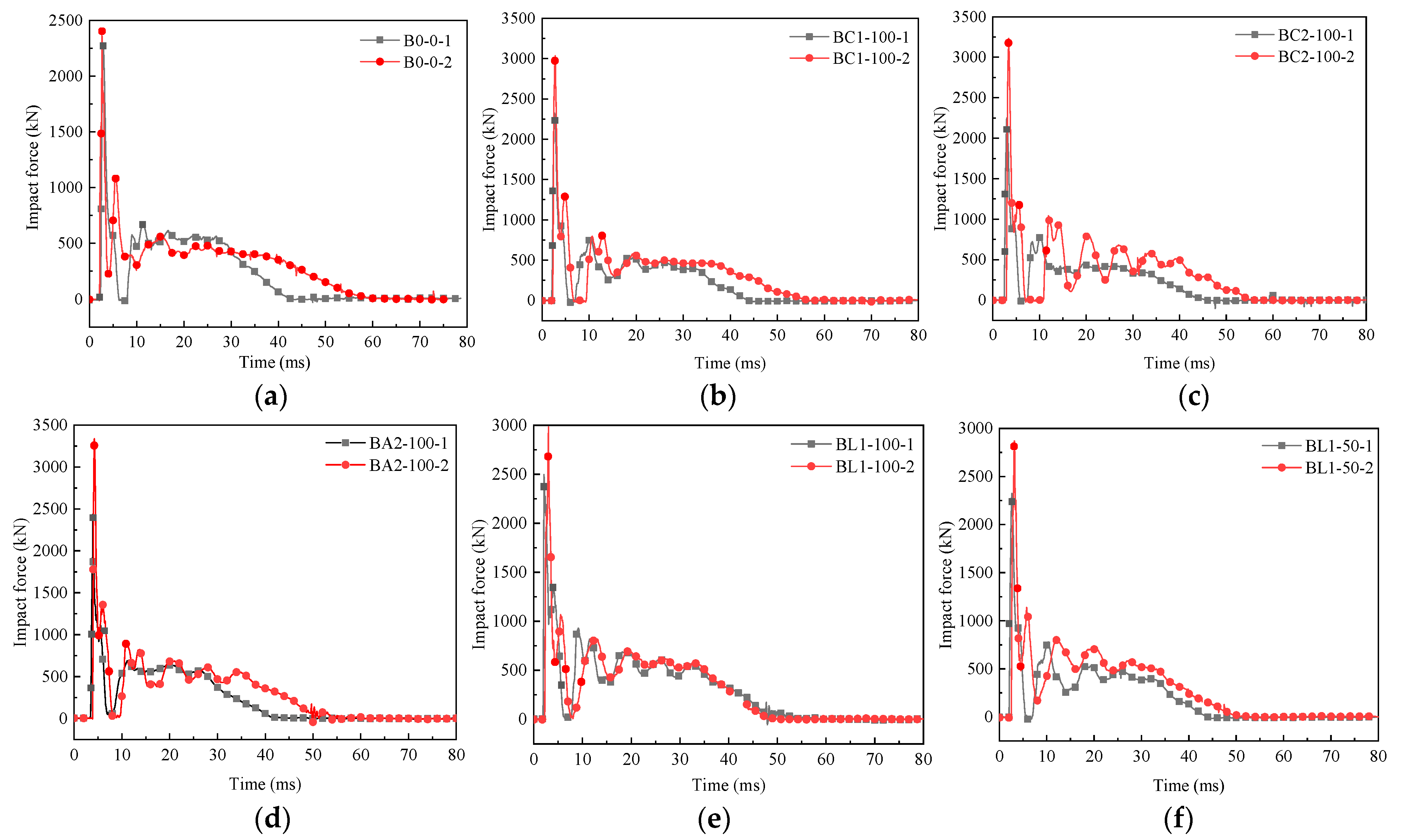
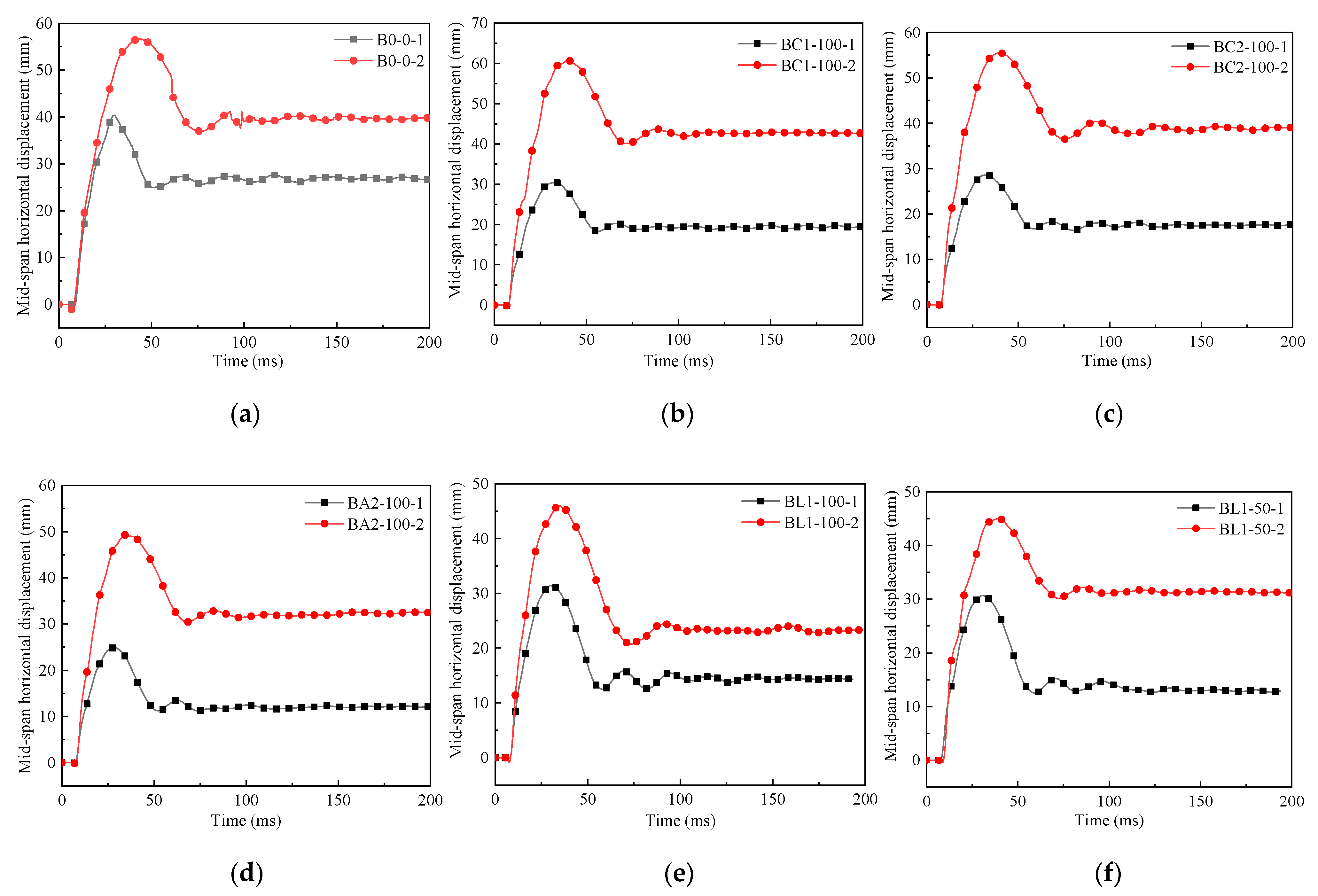
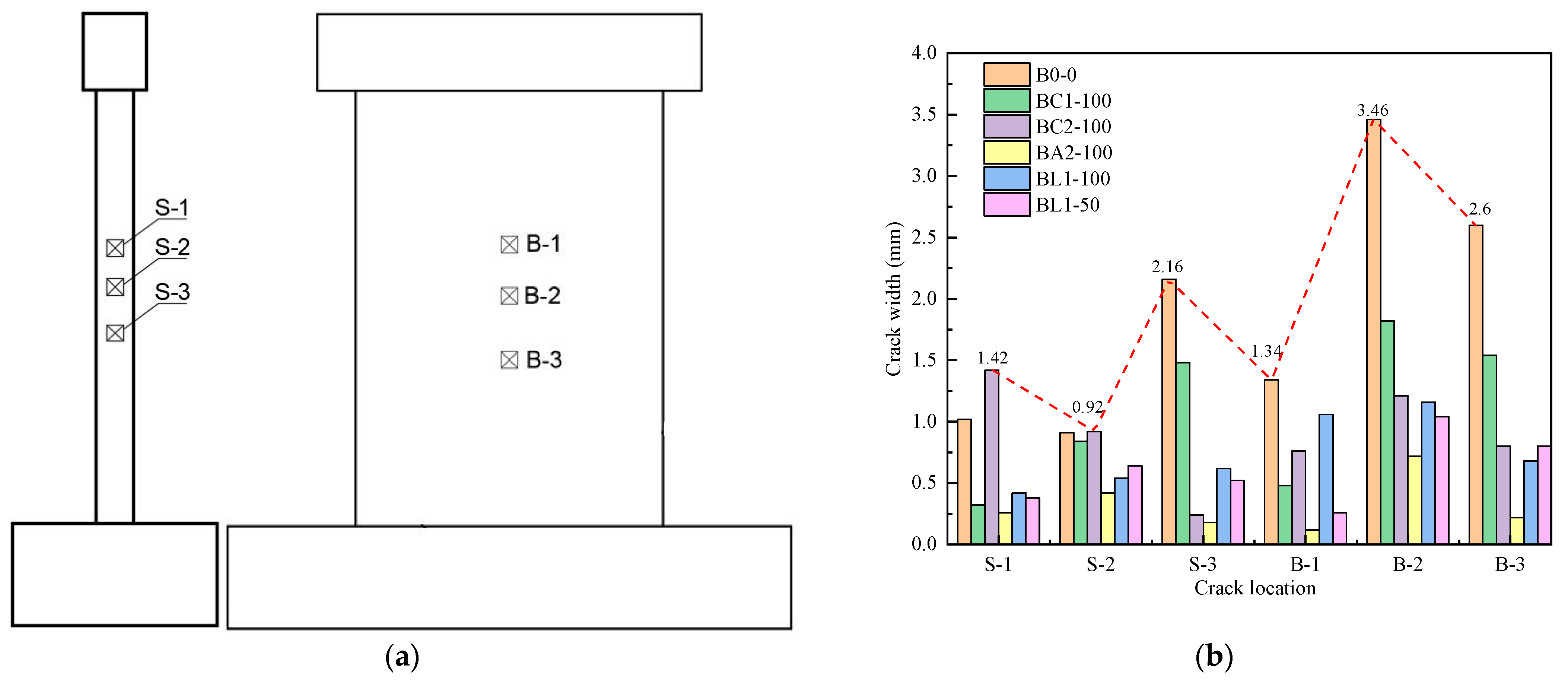

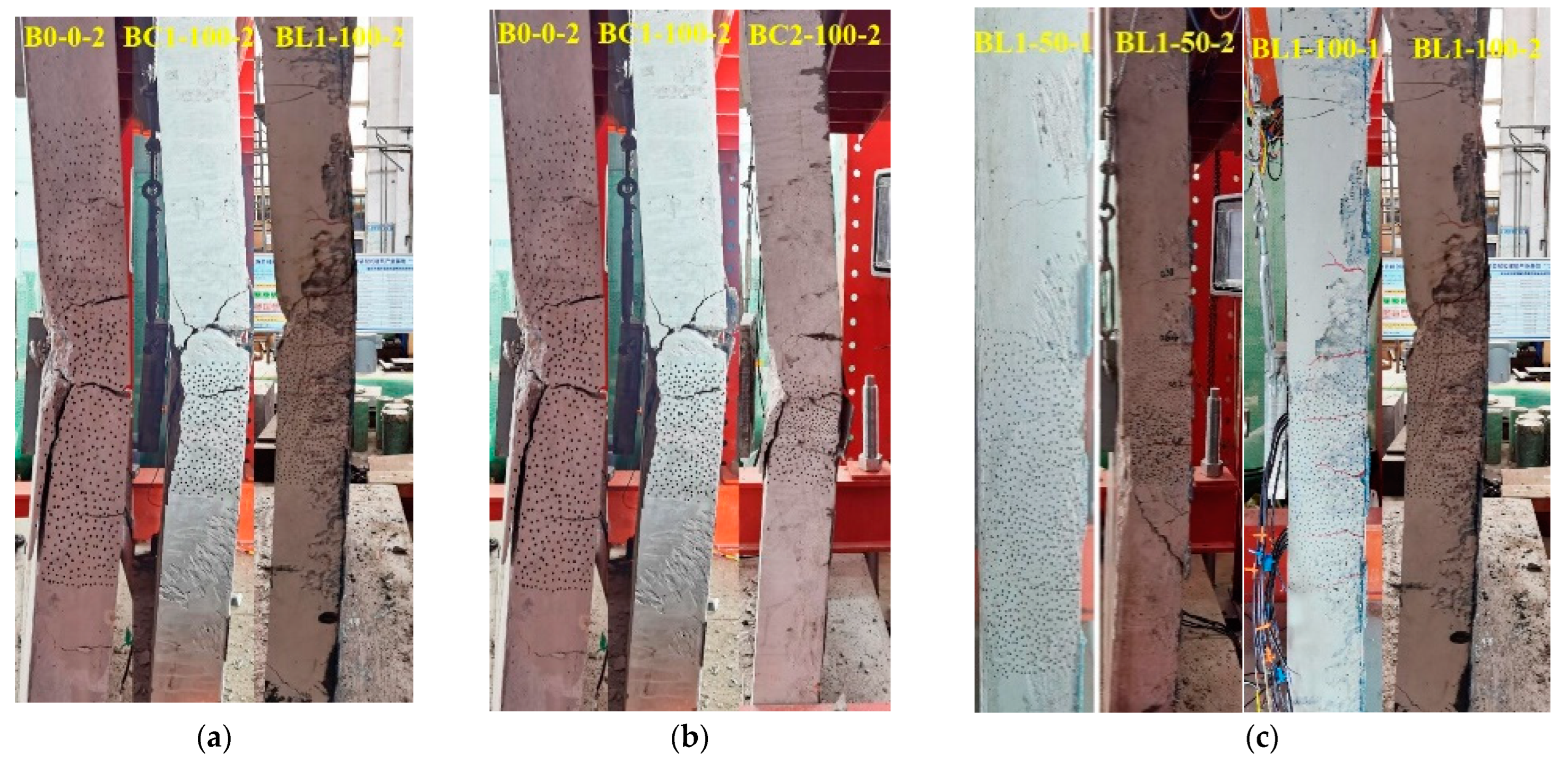

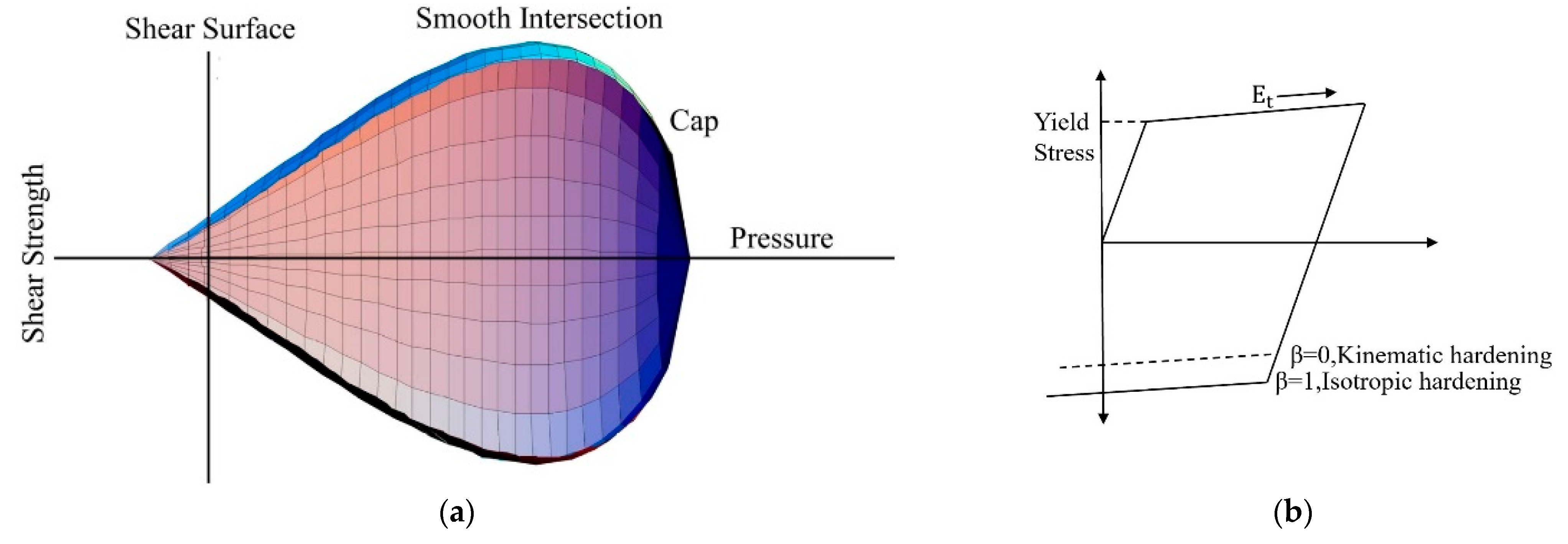




| Specimen Number | FRP Parameters | ||
|---|---|---|---|
| Layers (n) | Width (mm) | Spacing (mm) | |
| B0-0 | - | - | - |
| BC1-100 | 1 | 100 | 100 |
| BC2-100 | 2 | 100 | 100 |
| BA2-100 | 2 | 100 | 100 |
| BL1-100 | 1 | 100 | 100 |
| BL1-50 | 1 | 50 | 100 |
| Material Category | Density (kg/m3) | Tensile Strength (mpa) | Elastic Modulus (gpa) | Tensile Strain at Break (%) | Thickness (mm) |
|---|---|---|---|---|---|
| CFRP | 1500 | 3540 | 240 | 1.5 | 0.167 |
| AFRP | 1440 | 2195 | 67 | 2.2 | 0.193 |
| LRS-FRP | 1384 | 740 | 18 | 7 | 0.841 |
| Tensile Strength (MPa) | Flexural Strength (MPa) | Tensile Shear Strength (MPa) | Compressive Elastic Strength (MPa) | Compressive Yield Strength (MPa) |
|---|---|---|---|---|
| 35 | 42 | 14 | 1.5×103 | 76 |
| Specimen Number | Impact Times | Maximum Impact Force (kN) | Maximum Mid-Span Displacement (mm) | Residual Displacement (mm) | Impact Recovery Factor (R) |
|---|---|---|---|---|---|
| B0-0 | 1 | 2289.2 | 40.4 | 26.9 | 0.33 |
| 2 | 2417.7 | 56.6 | 39.8 | 0.30 | |
| BC1-100 | 1 | 2324.8 | 30.3 | 19.1 | 0.37 |
| 2 | 3035.8 | 60.8 | 42.9 | 0.29 | |
| BC2-100 | 1 | 2249.4 | 28.6 | 17.5 | 0.39 |
| 2 | 3234.1 | 55.5 | 39.2 | 0.29 | |
| BA2-100 | 1 | 2435.6 | 24.8 | 12.2 | 0.51 |
| 2 | 3337.1 | 49.3 | 32.4 | 0.34 | |
| BL1-100 | 1 | 2498.1 | 30.4 | 14.4 | 0.53 |
| 2 | 2984.8 | 45.8 | 23.2 | 0.49 | |
| BL1-50 | 1 | 2327.4 | 30.8 | 13.2 | 0.57 |
| 2 | 2870.1 | 46.2 | 31.2 | 0.32 |
| Specimen number | S-1 | S-2 | S-3 | B-1 | B-2 | B-3 |
|---|---|---|---|---|---|---|
| B0-0 |  |  |  |  |  |  |
| BC1-100 |  |  |  |  |  |  |
| BC2-100 |  |  |  |  |  |  |
| BA2-100 |  |  |  |  |  |  |
| BL1-100 |  |  |  |  |  |  |
| BL1-50 |  |  |  |  |  |  |
| Material | Material Model | Material Parameters |
|---|---|---|
| Concrete | MAT_CSCM_CONCRETE | |
| Tension steel | MAT_PLASTIC_KINEMATIC | |
| FRP | MAT_ENHANCED_COMPOSITE _DAMAGE | Table 2 |
| Pendulum | MAT_ELASTIC | |
| Fixture device | MAT_RIGID |
| Specimen Number | Peak Impact Force (kN) | Peak Mid-Span Horizontal Displacement (mm) | ||||
|---|---|---|---|---|---|---|
| Experimental | Simulation | Error | Experimental | Simulation | Error | |
| B0-0 | 2289.2 | 2070.3 | 9.6% | 40.1 | 46.0 | 14.7% |
| BC1-100 | 2324.8 | 2211.0 | 4.9% | 30.3 | 28.6 | 5.6% |
| BC2-100 | 2249.4 | 2062.5 | 8.3% | 28.6 | 25.3 | 11.5% |
| BA2-100 | 2435.6 | 2235.8 | 8.2% | 24.8 | 23.5 | 5.2% |
| BL1-100 | 2498.1 | 2386.2 | 4.5% | 30.4 | 29.3 | 3.6% |
| BL1-50 | 2327.4 | 2123.3 | 8.8% | 30.8 | 31.4 | 1.9% |
Publisher’s Note: MDPI stays neutral with regard to jurisdictional claims in published maps and institutional affiliations. |
© 2022 by the authors. Licensee MDPI, Basel, Switzerland. This article is an open access article distributed under the terms and conditions of the Creative Commons Attribution (CC BY) license (https://creativecommons.org/licenses/by/4.0/).
Share and Cite
Shi, C.; Zhang, J.; Liang, H.; Xu, H.; Liu, F.; Zhao, Y. Study on the Impact Resistance of FRP Pasted onto a Blastproof Partition Wall under Out-of-Plane Repeated Impact Load. Coatings 2022, 12, 1836. https://doi.org/10.3390/coatings12121836
Shi C, Zhang J, Liang H, Xu H, Liu F, Zhao Y. Study on the Impact Resistance of FRP Pasted onto a Blastproof Partition Wall under Out-of-Plane Repeated Impact Load. Coatings. 2022; 12(12):1836. https://doi.org/10.3390/coatings12121836
Chicago/Turabian StyleShi, Chenglong, Jigang Zhang, Haizhi Liang, Hongjian Xu, Feifei Liu, and Yang Zhao. 2022. "Study on the Impact Resistance of FRP Pasted onto a Blastproof Partition Wall under Out-of-Plane Repeated Impact Load" Coatings 12, no. 12: 1836. https://doi.org/10.3390/coatings12121836
APA StyleShi, C., Zhang, J., Liang, H., Xu, H., Liu, F., & Zhao, Y. (2022). Study on the Impact Resistance of FRP Pasted onto a Blastproof Partition Wall under Out-of-Plane Repeated Impact Load. Coatings, 12(12), 1836. https://doi.org/10.3390/coatings12121836





